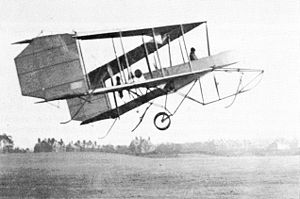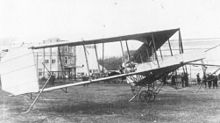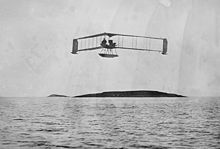- Dunne D.8
-
D.8 Dunne D.8 at Farnborough, 11 March 1914 Role Experimental aircraft National origin United Kingdom Manufacturer Blair-Atholl Syndicate Ltd, London Designer J. W. Dunne First flight June 1912 Primary users Royal Flying Corps
US Signal Corps
United States Navy
Canadian Aviation CorpsNumber built 5 Developed from Dunne D.5 The Dunne D.8 of 1912 was one of a series of tailless swept wing biplanes, designed by J. W. Dunne to have inherent stability. One of the few built was the only Dunne aircraft to fly, albeit very briefly, with the Royal Flying Corps (RFC). Others were used by the US Signal Corps and United States Navy and the short-lived Canadian Aviation Corps. It was the latter's first and only warplane.
Contents
Design and development
J. W. Dunne's first swept biplane wing aircraft, designed to have automatic stability, dated from his employment at the Balloon (later) Aircraft Factory at Farnborough during 1906–09. To preserve military secrecy testing was done at Blair Atholl in Scotland. After leaving Farnborough, Dunne set up a private company, the Blair-Atholl Syndicate Ltd. Its first aircraft was the Dunne D.5.[1][2] When this crashed in 1911 it was rebuilt as the D.8.[3][4][5] The two models shared very similar wings and the same engine, but the D.8 had a single pusher propeller instead of the chain-driven pair of the D.5. Their fuselages and undercarriages were also different.
The D.8 was a tailless four bay unstaggered biplane with its wings swept at 32°. Its constant chord wings were built up around two spruce spars, the forward one forming the leading edge. To help achieve stability the incidence and interplane gap decreased outboard, the former becoming negative. This washout on tips well behind the centre of gravity provided longitudinal stability in the same way as a conventional tailplane, set at lower incidence than the wings. Camber increased outwards. Simple, near parallel, pairs of interplane struts joined the spars. The outer interplane struts were enclosed with fabric, forming fixed side curtains that provided directional (yaw) stability. Wing tip elevons were used for control, operated by a pair of levers, one either side of the pilot. The D.8 initially used just a pair of these, mounted on the upper wing, a rectangular cutout in the side curtains allowing for their movement as on the D.5.[2][4] Large parts of the aircraft were built by Short Brothers.[6]
The D.8's water-cooled 4-cylinder, 60 hp (45 kW) Green engine directly drove a four-bladed[4] pusher propeller, saving weight compared with the D.5's chain drive.[3] Though it is not certain when the propeller was changed, most photographs show the Green engine driving a two-bladed airscrew.[4] As a consequence of the propeller position the fuselage was shortened at the rear; it was also extended in the nose. This first D.8 seems to have been a single-seater like its D.5 predecessor,[1] the pilot sitting at mid chord.
Contemporary sources remarked on the complexity of the D.8's undercarriage, which combined a narrow track pair of sprung wheels pair with wingtip skids. Part of its complication came from opposing springing in the absence of dampers, and part from an elaborate anti-noseover skid.[5]
In this form the D.8 first flew in June 1912 at Eastchurch.[4] It attended the Larkhill Military trial in August 1912, though it did not take part in the competition. It flew regularly at Eastchurch through 1911 and 1912 and was still active there in November 1912.[7] Despite the two handed arrangement of the D.8's controls, the one-handed Capt. A.D. Carden gained his Royal Aero Club Aviator's Certificate on it in June 1912.[8]
It is not known if this machine was later modified aerodynamically, but by August 1913 the Green engine had been replaced by an 80 hp (60 kW) 7-cylinder Gnome rotary engine.[3] This much shorter engine also powered the second aircraft, which was a two-seater with the pilot placed just ahead of the wing leading edge and the passenger (who had dual control) at the trailing edge.[5] There were now control surfaces on both upper and lower wings, the side curtains having a pair of tapered notches to allow them to move. Each of the upper wings carried a pair of elevons, nearly doubling the control surface area,[5] though it is not certain if these moved as one or differentially.[4] It first flew, with Felix at the controls, on 18 October 1913.[4]
In August 1913 Commandant Felix piloted a D.8 across the English Channel from Eastchurch to Villacoublay. Nieuport had obtained a licence to build the D.8 and Felix gave demonstration flights in France on their behalf.[8]A Nieuport-built Dunne appeared at the Paris Aero Salon in December 1913. Like the second D.8 it was a Gnome powered two-seater, but with significant differences both aerodynamically and structurally. It combined the double upper wing elevons into a single surface and had very rounded rear wingtips.[9] The fuselage was slightly modified and built around steel tubes rather than wood. The interplane struts were streamlined steel tubes. It also had a strikingly simplified undercarriage.[10]
Dunne had obtained a War Office order for two D.8s, though one was cancelled because of late delivery. One, possibly the machine flown in October 1913 and certainly similar to it, was delivered to Farnborough on 3 March 1914. It made several flights on 11 March piloted by N.S.Percival, who had flown the first D.8 many times at Eastchurch and was now a RFC officer. Though it carried the RFC number 366, there is no record of it flying again though it may have survived until at least the summer of 1914.[3] The general judgement was that in the search for balance between stability and controllability, the Dunne design overemphasised the former.
Variants
- D.10 A shorter span (45 ft, 13.7 m) two-seat Gnome powered version, later converted to D.8.[11]
- Burgess-Dunne The Burgess Company and Curtiss, based in Marblehead, Mass, USA gained the US manufacturing rights and built a series of aircraft based on the D.8. They became known as Burgess-Dunne machines and were mostly single-float planes. The first flew in March 1914,[12] piloted by Clifford Webster. Apart from wingtip floats the wings were identical to those of the D8, but the fuselage was revised with a distinct nacelle containing a more enclosed cockpit. The aircraft was a single-seater, with the heavier 100 hp (75 kW) Curtiss OXX2 water-cooled engine moved forwards, shortening the fuselage and with its radiator placed between engine and pilot. The single float was 17 ft 8 in long (5.38 m), shallow and flat bottomed viewed from in front, with a single step. The prototype behaved well in the air and on the water.[13] The second machine was very similar to the first, but room was made for a second seat by replacing the single fuselage mounted radiator with a pair fixed to the rear float struts.[12]
- The second machine was bought by the Canadian government for the Canadian Aviation Corps and was their first military aircraft. It was shipped to Europe for service in World War I, but was seriously damaged in transit and not used. The third machine, another two-seater but powered[14] by a Salmson M-9 radial providing 135 hp (100 kW), was delivered to the US Signal Corps in either 1914 or 1915.[15] Two were also delivered to the US Navy[16] as type AH-7, fitted with a 90 hp (60 kW) Curtiss engine[14] and AH-10 with the 100 hp Curtiss. The latter set a US altitude record of 10,000 fft (3,050 m) on 23 April 1915.[14] One Burgess-Dunne was configured as a landplane for a time.[17][18]
- The Dunne-Burgess types were[19]
- BDI - as the prototype.
- BD - as the second aircraft, first aimed at the military market then as a sports plane.[14]
- BDH - a two-seater with a 140 hp (104 kW) Sturtevant V-8 engine[14] and a slightly increased span (46 ft, 14.0 m).
- BDF - a three-seat, flying boat variant with the Curtiss engine but a span increased to 53 ft (16.2 m).
There is a full scale, non-flying replica of a Burgess-Dunne in the RCAF Memorial Museum, CFB Trenton, Ontario,[20] largely built by Barry D. MacKeracher.
Specifications (second aircraft)
Data from Goodall & Tagg 2001, p. 105
General characteristics
- Crew: 1
- Length: 25 ft 9 in (7.85 m)
- Wingspan: 46 ft 0 in (14.02 m)
- Wing area: 545 sq ft (50.6 m2)
- Empty weight: 1,400 lb (635 kg)
- Gross weight: 1,900 lb (862 kg)
- Powerplant: 1 × Gnome 7-cylinder rotary, 80 hp (60 kW)
Performance
- Maximum speed: 56 mph (90 km/h; 49 kn)
- Rate of climb: 500 ft/min (2.5 m/s) [3]
See also
- Related lists
References
- Notes
- ^ a b "The Dunne Aeroplane" (pdf). Flight. 18 June 1910. pp. 459–462. http://www.flightglobal.com/pdfarchive/view/1910/1910%20-%200461.html.
- ^ a b Flight 25 June 1910 pp.477–481
- ^ a b c d e Bruce 1992, pp. 221–3
- ^ a b c d e f g Goodall & Tagg 2001, pp. 104–6
- ^ a b c d Flight 15 September 1913 pp.1241–5
- ^ Barnes & James 1989, p. 506
- ^ Flight 23 November 1912 pp.1082
- ^ a b Lewis 1962, p. 228
- ^ Flight 13 December 1913 p.1328
- ^ Flight 3 January 1914 p.7
- ^ Goodall & Tagg 2001, p. 106
- ^ a b Flight 25 June 1914 pp.644–647
- ^ Flight 2 May 1914 p.476
- ^ a b c d e Aerofiles
- ^ Fahey 1946, p. 6
- ^ Aviation Pioneers
- ^ E. Jones Aeronautical Collection
- ^ Boston Evening Transit 18 July 1914
- ^ Lewis 1962, p. 229
- ^ Burgess-Dunne replica
- Bibliography
- Atholl, Katherine. "AIR PIONEERS" The Times (London). Friday, 18 Dec 1953. Issue 52808, col D, p. 9.
- Barnes, C.H.; James, D. N. (1989). Shorts Aircraft since 1900. London: Putnam Publishing. ISBN 0 87021 662 7.
- Bruce, J.M. (1992). The Aeroplanes of the Royal Flying Corps (2nd ed.). London: Putnam Publishing. ISBN 0 85177 854 2.
- Fahey, James C (1946). US Army Aircraft. New York: Ships & Aircraft Ltd.
- Goodall, Michael H.; Tagg, Albert E. (2001). British Aircraft before the Great War. Atglen, PA, USA: Schiffer Publishing Ltd. ISBN 0 7643 1207 3.
- Lewis, Peter (1962). British Aircraft 1809-1914. London: Putnam Publishing.
Aircraft produced by John William Dunne D.1 • D.2 • D.3 • D.4 • D.5 • D.6 • D.7 • D.8 • D.9 • D.10 • Dunne-Huntington triplane • Dunne-Capper monoplane • Burgess-Dunne
Lists relating to aviation General Aircraft (manufacturers) · Aircraft engines (manufacturers) · Airlines (defunct) · Airports · Civil authorities · Museums · Registration prefixes · Rotorcraft (manufacturers) · TimelineMilitary Accidents/incidents Records Categories:- British experimental aircraft 1910–1919
- Dunne aircraft
- Rotary-engined aircraft
- Tailless aircraft
- Single-engine aircraft
- Pusher aircraft
Wikimedia Foundation. 2010.



